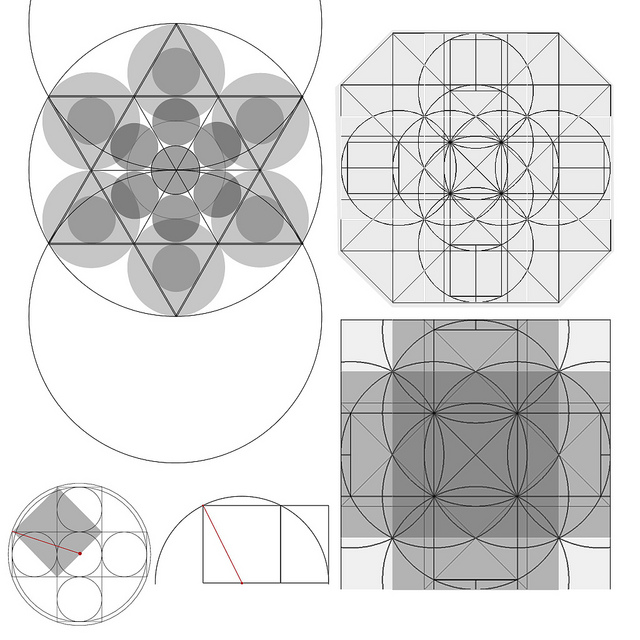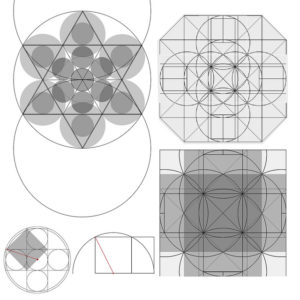
Meeting secretary: Dam’el of Azpaluna
Vanaten the Founder:
I have been one of the closest collaborators and friends of Mr. Sirvain of Chargui for the better part of twenty years.
Now, out of respect for the truth, I must submit to the judgement of the noble Academy of Architecture and Urbanism and its esteemed members a piece of vital information which, I believe, will accomplish the twin goals of rectifying our history and saving our reputation.
In all textbooks and biographies I have read, Mr. Chargui is presented as a fervent supporter of mathematical order, to the point that some have speculated on his ties to the Sect of the Jade Sextant, a rumor which I am unfortunately unable to confirm or dispel with certainty.
[Clamor from the stands. The meeting chairman restores order.]
Please, dear colleagues, I do not wish to enter into sterile political debate. These documents, as I said, present my ex-colleague and friend as a follower of stratospheric Reason, but I am sorry to say this is not so!
[The clamor resumes. The meeting chairman demands silence.]
Indeed, this is the truth, the unfortunate truth. Mr. Lubvan may squirm in his seat all he wants [Mr. Lubvan makes a disdainful gesture], but fact is still fact. Sirvain possessed many personal writings about ancient beliefs in sacred geometry, and I have reason to declare that he has applied the same principles to most of his works, the earliest example being the construction of the Unfounded Tower.
Meeting Chairman:
Vanaten, would you be so kind as to explain these beliefs to the youngest among the architects that sit on this committee today?
Vanaten the Founder:
Of course, Mr. President. Sacred geometry is a very ancient doctrine that consists in designing buildings, especially places of worship, according to patterns believed to hold divine or magical properties. The cube, the circle, the triangle and so on; each holds its own symbology, and, some supposed, a link to unfathomable forces. Modeling buildings after such ancestral designs meant empowering the connection between those forces and the places in question. Ley lines, portals, life after death… And so on, and so on.
Sometimes, the shape of the building simply expressed an ambition or hope, but the architect’s hubris often went further.
The main principle was that the world obeys to forces that can be directed and summoned through geometry. Your architecture, my dear sirs, would no longer be the pure work of reason and logical excellence, but rather the simple translation of Nature’s will, or old wives’ tales, superstitions reflected in all aspects of the universe. Imagine, then, such a principle applied not just at the scale of a simple building, but to the topography of an entire region.
[Whispers in the hall]
Observe, if you will, these documents I received from Sirvain himself back when we still worked together. We shall focus on the first draft, on the upper left, showing the layout of the earthwork he planned around Auster Abbey, in the northern region of the Great Delta.

Surely you recognize the volcano at the center of this map, whose summit is marked here with an X. The lighter circles will naturally remind you of the farmland basins down in the valley, and it is consequently obvious that the triangles here mark the main wind currents that have irrigated Auster ever since the region’s remodeling.
I see your disgusted face, Mr. Thiphos-Typhon, and I understand. If the Academy had been aware of this design, Mr. Chargui would certainly not have received the authorization required to execute his plans. Now we know he only submitted partial projects to the Committee; they were of high quality, of course, but they always kept us from seeing… My winds, they have always kept us from seeing all of this.
Meeting Chairman:
We grant Mr. Hermande the Brown permission to speak.
Hermande the Brown:
Mr. Founder, thank you for your clear and coincise explanation. However, you will forgive my lack of knowledge in this field of pagan activity… I fail to see the problem with our colleague’s work. After his developments, Auster Valley has turned into a wealthy, dynamic, extremely windy region. Surely we can all be happy with it, can we not?
Vanaten the Founder:
Mr. Brown, you are right about that. However, is it not a disgrace that such a prestigious member of our Academy become the mind behind such an unscientific endeavor? Oh, I know, you geometricians will assure me his planimetry is perfect, and it really is. But look with your mind, rather than just your eyes. Of course it would be impossible for us to destroy the building, as it is still a technological marvel. However, I beg you to listen: Sirvain of Chargui can no longer be called an Urbanist!
[Yelling in the hall. The chairman bangs his gavel and Mr. Founder screams over the din.]
He cannot, and he must not! Urbanism is the great rule of reason applied to the world! It is what elevates its landscapes and its souls! Mr. Chargui is an impostor, an accursed heathen corrupted by the idiocy of the still lands and the obtuse minds he fraternized with there! The Academy must strip him of his title, here and now!
Minutes of the petition submitted by Mr. Vanaten, Founder of the Academy of Architecture and Urbanism
